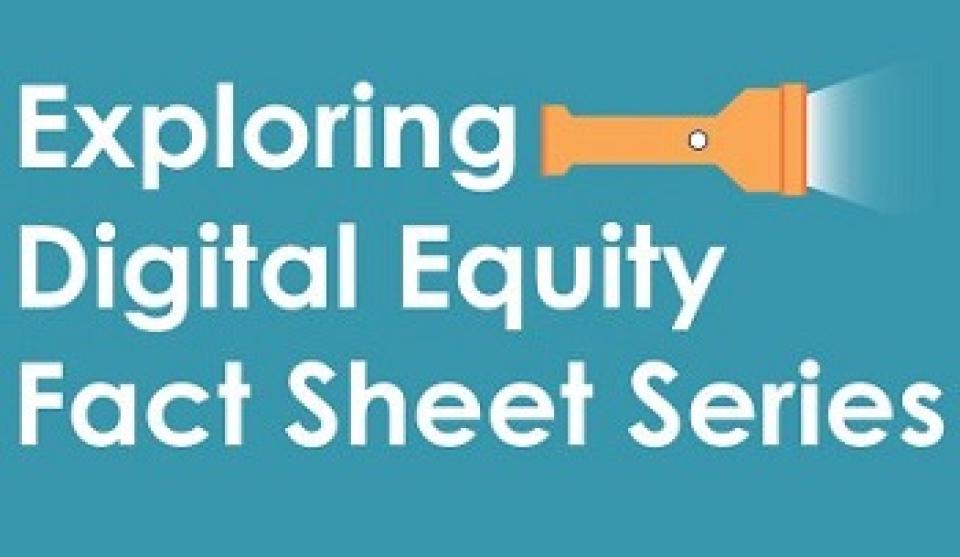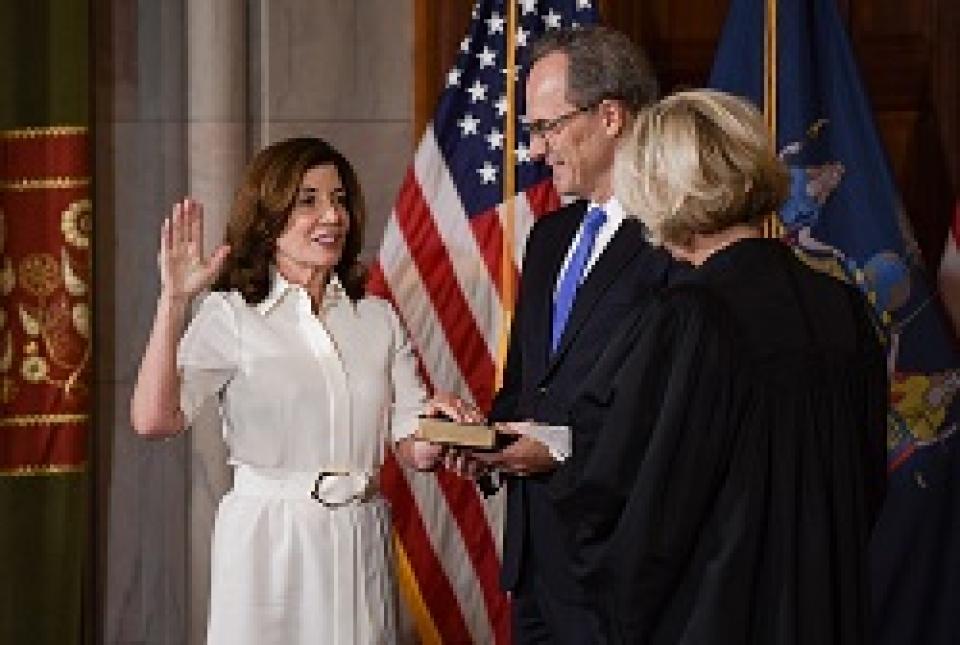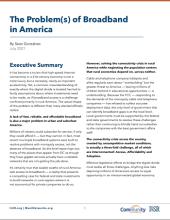
Fast, affordable Internet access for all.

The Biden Administration is poised to celebrate the nation's largest telecommunications monopolies today even as these companies do the bare minimum for digital equity while undermining his administration's broadband agenda.
Christopher Mitchell, Director of the Community Broadband Networks Program at the Institute for Local Self-Reliance, had this to say today about the undue influence of Big Telecom and its effort to block the confirmation of GiGi Sohn as an FCC commissioner:
As we enter the third year of a pandemic that has supposedly redefined the crucial importance of broadband, the Federal Communications Commission has failed to update the definition of broadband it set in 2015. Few expect the FCC to publish accurate maps of where broadband is until 2023. It might help if President Biden seated his third commissioner.
The Biden Administration took a painfully long time to nominate the most obvious candidate for the position - Gigi Sohn - and has done precious little to have her confirmed in a reasonable time frame. Though it would be easy to blame Republican opposition, the truth is that it simply does not appear to be a priority for the Administration.
We join the effort to praise all companies that are helping move toward digital equity, but if simply discounting the cost of service from cable and telephone providers were sufficient, we might have less of a problem now, 11 years after Comcast launched Internet Essentials. To actually connect everyone, we will need an effective FCC as well as local engagement. However, some of the very companies being praised by the President today are spending millions in lobbying and ad-blitzes to prevent Gigi Sohn from being confirmed and to stop needed investments.
If they succeed in blocking Gigi, they will have confirmed something else: that they are the actual regulator of telecom services and the Biden Administration is not serious about the lofty goals it set in 2021.
What is digital equity? And why is access to ubiquitous, reliable and affordable high-speed Internet service so vital? The technological issues involved can sometimes seem confusing, especially for those who came of age before the Internet fundamentally transformed how we interact.
That’s why the Institute for Local Self Reliance, with support from AARP, has created the Exploring Digital Equity Fact Sheet Series. The series contains six user-friendly, easy-to-understand fact sheets to help demystify the challenges associated with creating digital equity.
We are releasing the entire series today, while AARP will feature the fact sheets as part of its Livable Communities initiative, an effort to support neighborhoods, towns, cities and rural areas in creating safe, walkable streets; age-friendly housing and transportation options; access to needed services; and opportunities for residents of all ages to participate in community life.
Both ILSR and AARP have created landing pages for the fact sheets as well. You can find our landing page here, and the fact sheet landing page for AARP here.

The fact sheets series ultimately highlight how expanding Internet access to everyone who wants it isn’t an infrastructure problem alone. Achieving digital equity for everyone in a community is a multi-faceted endeavor, and requires engaging and activating an array of stakeholders. The Exploring Digital Equity Fact Sheet Series unpacks the issues, challenges, and opportunities today.
Two decades into the twenty-first century, it still feels a little strange to justify all of the obvious ways that Internet access serves as a key pillar among the social determinants of health (SDOH) that govern our individual and collective wellbeing. The concept itself is at least two hundred years old: a German pathologist named Rudolph Virchow is often quoted as saying in the late 1840s, in response to the privation he saw in the run-up to the 1848 revolutions, that “medicine is a social science and politics is nothing else but medicine on a large scale.”
Our modern framing of the problem comes in large part from the World Health Organization, which in the preamble to its 1946 constitution wrote that “health is a state of complete physical, mental and social well-being and not merely the absence of disease or infirmity.” In 2020, the FCC has called broadband access a “super social determinant of health” in 2020, precisely because it serves as a gateway to all of the other elements of life that foster healthiness and wellbeing, from access to education, information, better food, economic opportunity, and socialization.
But a recent study published to the JAMA Open Network makes the connection even more explicit. In it, a team of researchers at The Center for Spatial Data Science at the University of Chicago show that a lack of Internet access has been strongly correlated with higher Covid-19 mortality rates across every type of household and in rural, suburban, and urban areas alike.
Internet Access Most Strongly Correlated with Covid-19 Mortality Rates
Written by Christine Parker and Ry Marcattilo-McCracken
A recent report by BroadbandNow made the rounds in February, with the authors concluding that the average price for broadband access across all major speed tiers for Americans has fallen, by an average of 31 percent or nearly $34/month, since 2016. At a glance, this is great news – perhaps affordable Internet access for all is within reach?
Readers following up to check out the report itself would be well justified in coming to the same conclusion, with BroadbandNow writing in the first paragraph that “we’ve found that prices have decreased across all major download speeds (25Mbps up to 1Gbps+) and technologies (cable, fiber, DSL and fixed wireless).” Immediate news coverage reinforced the report’s points.
But you don’t have to follow broadband policy closely to get the sense that something a little off is going on here. It feels like every day there’s a story like this one about Cable One, with a provider increasing speeds as it improves its network infrastructure and then raising rates while removing the slowest tier options. Charter and Comcast, for their part, do this nearly every year whether pairing it with speed increases or not. Is broadband access getting cheaper, or more expensive? What’s going on here?
The reality is that this report from BroadbandNow, unfortunately, poorly frames the national broadband marketplace. At best, it muddies the waters with a lack of clarity about the relationship between broadband access speed tiers and relative pricing. At worst, it leaves the average reader with the incorrect assumption that broadband prices must be falling, and gives the monopoly cable and telephone companies ammunition to push for millions more in taxpayer dollars while building as little new infrastructure as possible.
Community broadband advocates in New York rang in the new year celebrating Gov. Kathy Hochul’s announcement of a proposed $1 billion investment to beef up broadband in the Empire State. If state lawmakers move to enact the initiative, it would be what the Governor’s office describes as “the largest ever investment in New York's 21st century infrastructure.”
During her State of the State speech, Gov. Hochul unveiled the ConnectAll Initiative, which aims to “deliver affordable broadband to millions of New Yorkers and transform the state's digital infrastructure through new investments,” with municipal broadband as a centerpiece of the plan.
In announcing the new initiative – which would be funded with a combination of up to $300 million in state funds, $345 million in federal funds, with the rest to eventually come from the recently passed Infrastructure Investment and Jobs Act – Gov. Hochul said:
The pandemic exposed how without broadband Internet, New Yorkers can be disconnected from school, work, and families. The ConnectALL Initiative will empower local municipalities and state agencies to set up nation-leading broadband infrastructure statewide, ensuring that every New Yorker has access to the Internet when they need it.
Six-Part Strategy

The plan not only creates a new ConnectALL Office, it directs the office to work in conjunction with other state agencies in overseeing the major components of the effort, following a six-part strategy that includes:
Communities across the United States got an unexpected gift from the Biden Administration last week in the form of additional flexibility to use Rescue Plan funds for needed broadband investments, particularly those focused on low-income neighborhoods in urban areas.
When Congress developed and passed the American Rescue Plan Act, it tasked the Treasury Department with writing the rules for some key programs, including the State & Local Fiscal Recovery Funds (SLFRF). That program is distributing $350 billion to local and state governments, which can use it for a variety of purposes that include broadband infrastructure and digital inclusion efforts.
Treasury released an Interim Final Rule in May, 2021, detailing how local governments would be allowed to invest in broadband. I promptly freaked out, at the restrictions and complications that I (and others) feared would result in local governments backing away from needed broadband investments due to fears of being out of compliance with the rule.
After we worked with numerous local leaders and the National League of Cities to explain the problems we saw in the proposed rule, Treasury released updated guidance in the form of a Q&A document to explain how local governments would be able to build and partner for needed networks.
Given the many challenges the Biden Administration has had to deal with, we did not expect significant new changes to the Rescue Plan rules around the SLFRF. But after many months of deliberations, the Treasury Department has resolved all of the concerns that we identified as areas of concern in May.
As we explain below, local governments have wide latitude to use SLFRF funds for a variety of needed broadband infrastructure investments, especially to resolve affordability challenges.
Summary and TL;DR
The rest of this post will cover some key points in the Final Rule with references to the text in the hopes that it will help communities better understand their options and share key passages with their advisers and attorneys.
While a national debate rages over immigration and the border wall, just 30 miles north of the U.S.-Mexico border, Harlingen city officials are coming together to plan the building of a bridge – across the digital divide deep in the heart of the Rio Grande Valley.
When Harlingen (pop. 75,000) was founded at the turn of the 20th century, it established itself as a prominent commerce and transportation hub – the “Capital of the Rio Grande Valley” at “the crossroads of South Texas.” Over the years, thanks to its fertile delta soil, the cultivation of citrus fruit, grain, and cotton became a major part of the local economy. Today, however, the biggest industry in the second most populous city in Cameron County is healthcare.
As attractive as Harlingen has become to residents and visitors – with its extensive park system and tropical bird-watcher’s paradise (the city happens to be located where two primary avian flyways converge) – one thing the city lacks is adequate access to broadband, which is particularly acute among households with school-aged children.
Pandemic Spurs City into Action
That realization was the impetus behind a recent city commission vote to move forward with a feasibility study to determine how the city might build a broadband network and whether it should rely on fiber, fixed wireless, or a mix of deployment technologies to modernize Harlingen’s telecommunications infrastructure.
“What brought this to our attention was of course the pandemic,” City Manager Gabriel Gonzalez told Valley Central News. “When the school district had to go to virtual learning, we found out that there were students and some families that did not have access to (the) Internet.”

As the Biden Administration is working with Senate Republicans and Democrats on a proposed infrastructure deal which now includes a $65 billion federal investment to expand broadband access, the details of how that money should be spent and where those investments should be targeted have yet to be decided.
In a new policy brief, the Institute for Local Self-Reliance looks to provide clarity for policy-makers by exploring the real challenges of America’s connectivity crisis. The brief aims to clear up a common misunderstanding of exactly where the digital divide is located.
Digital Divide is Not Urban Vs. Rural, It’s Both
It does so by explaining why high-speed Internet access is not a challenge confined primarily within rural America. A lack of fast, reliable, and affordable broadband is also a major problem in urban and suburban America.
As the brief details, millions of citizens could subscribe for service right now, if only they could afford it — but they cannot. In fact, most recent municipal broadband systems were built to resolve problems with monopoly excess, not the absence of broadband. Many of the places that appear from the DC as though they have gigabit services actually have unreliable networks that are not getting the job done.
The Case for Prioritizing Local Community Efforts
The brief further elaborates on how America’s connectivity crisis has been created by uncompetitive market conditions, a dilemma that actually presents three interconnected challenges: Access, Affordability and Adoption.
Finally, the brief makes the case for why the federal and state governments should support local governments in resolving these challenges, rather than continuing to blindly hand out subsidies to the companies with the best government affairs' staff.
From New York City to Newfield in Upstate New York, local officials in the Empire State have kicked off projects to connect the unconnected to high-speed Internet service.
The biggest of those projects is underway in New York City as Mayor Bill de Blasio recently delivered an early Christmas present for city dwellers who want to see a term-limit set on the digital divide in the Big Apple.
America’s most populous metropolis (est. pop. 8.6 million) is investing $157 million to build publicly owned, open access broadband infrastructure that will lay the groundwork local officials say will enable high-speed wireless Internet access for up to 1.6 million city residents over the next 36 months.
Even as the city is on track to bring free or low-cost Internet service to 40,000 residents living in 18 New York City Housing Authority (NYCHA) developments by the end of the year, this latest initiative aims to expand the city’s existing fiber infrastructure while drawing on minority and women-owned Internet Service Providers to help deliver “fast, reliable, and affordable connectivity options to an additional 70,000 NYCHA residents and 150,000 residents in the surrounding communities by early 2022,” the Mayor’s Office explained in a press release announcing the initiative.
“Broadband isn’t a luxury, it’s a necessity,” de Blasio said. “We are closing the digital divide and bringing our city into the 21st century by reaching communities most in need.”
New York City Chief Technology Officer John Paul Farmer characterized the effort as evidence that city officials are “transforming the broadband marketplace.”
No matter your zip code, every New Yorker deserves an equal opportunity to participate in building our shared future. The New York City Internet Master Plan has enabled the Big Apple’s unprecedented progress in promoting digital equity and making that idealistic vision a practical reality. New York City’s bold new approach delivers cross-sector partnerships, incorporates cutting-edge technologies, upgrades performance, and ensures affordability for residents and businesses.
Mobilizing ‘NYC Internet Master Plan’
The Atlantic Telephone Membership Cooperative (ATMC) has worked to meet the communications needs of its members since its inception by the citizens of rural Brunswick County, North Carolina who were without telephone service in 1955. Nowadays, ATMC believes meeting members’ communications needs means ensuring all co-op members have access to gigabit fiber Internet service.
High-speed Internet access is currently available throughout 100 percent of the co-op’s service area in southeastern North Carolina. Most co-op members have access to fiber Internet service already, except for those living in ATMC’s Brunswick County service territory, where ATMC originally began offering Internet services.
Brunswick County is the last county ATMC needs to upgrade to fiber, in order to complete an overarching goal of delivering fiber-to-the-home Internet service to all existing members. The co-op recently announced it will soon start a project to replace all of its copper and coaxial wires in Brunswick County with fiber optic cables. It will cost $100 million dollars and take eight years to complete, but at the end of the project, all of the cooperative’s members in Brunswick County currently served by legacy infrastructure will be upgraded to fiber, offering even faster Internet access speeds and far greater reliability.
In the meantime, ATMC has increased the maximum broadband speed delivered to co-op members in Brunswick County from 200 megabits per second (Mbps) to 600 Mbps, a company press release states. Over 22,000 customers had their download speeds doubled without an increase in price.
“The project is slated to start in January 2022,” according to an ATMC press release announcing the project. “By constructing in the most densely populated communities first, the cooperative estimates that it can convert as many as 75 percent of homes and businesses to the new fiber optic network within the first 60 months.”